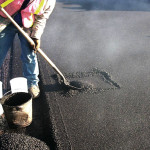
Hot Mix Asphalt is typically what one thinks of when installing driveways of new homes. It is by far one of the least expensive methods for paving a surface in new home construction sites. Properly installed asphalt paved driveways have a life expectancy of about 25 years or more . These asphalt paved driveways consist of rock particles, sand, and asphalt cement, which make it flexible and durable at the same time. New asphalt is by far the most flexible because it still retains many of the lighter hydrocarbon oils that make up its DNA structure. Crushed gravel makes up the foundation on which the asphalt is laid, to promote stability of the asphalt structure. By laying twelve inches of gravel beneath the asphalt you are ensuring a greater life expectancy for your asphalt driveway. This will give greater flexibility and allow your asphalt driveway to look as nice as it can for as long as possible.
The next step is to seal your asphalt driveway after about six to nine months. The new asphalt driveway must cure out over that time frame. If sealed to quickly, the hydrocarbon oils that give the asphalt paving its flexibility will cause it to be too flexible, thus, allowing greater marks to exist over time. When it is time to seal your asphalt paved driveway, remember to put at least two coats of high quality seal coat over the entire driveway. This is to be repeated every three to five years for the maximum life expectancy of your asphalt paved driveway. By being patient and following this advice, your asphalt paved driveway will be around for many years to come. Take good care of it and it will definitely add character to your home.
Hot Mix Asphalt is and will always be the best alternative for those seeking to pave surfaces in a flexible manner. To find other great tips about asphalt paving visit
What is Hot Mix Asphalt?
Hot mix asphalt (commonly abbreviated as HMA) is produced by heating the asphalt binder to decrease its viscosity, and drying the aggregate to remove moisture from it prior to mixing. Mixing is generally performed with the aggregate at about 300 °F (roughly 150 °C) for virgin asphalt and 330 °F (166 °C) for polymer modified asphalt, and the asphalt cement at 200 °F (95 °C). Paving and compaction must be performed while the asphalt is sufficiently hot. In many Cities, paving is restricted to summer months because in winter the compacted base will cool the asphalt too much before it is packed to the optimal air content. HMA is the form of asphalt most commonly used on highly trafficked pavements such as those on major highways, racetracks and airfields.
HL Mixes
HL3 is a surface course mix that can be used in parking lots or for residential driveways, it consists of 13mm Clear, 7mm Clear and 4mm Asphalt Sand and Asphalt Cement.
HL8 is a binder (base) course mix that consists of 19mm Clear, 13mm Clear, 17mm Clear, 4mm Asphalt Sand and Asphalt Cement.
MDBC (Medium Duty Binder Course) is a binder course for roads with moderate truck traffic. The mix consists of 19mm Clear, 13mm Clear, 17mm Clear, 4mm Asphalt Sand and Asphalt Cement. This mix will have 10 to 20% R.A.P. (Recycled Asphalt Pavement) in it.
HL3R is a surface course mix that can be used in parking lots or residential driveways, the mix consists of 13mm Clear, 17mm Clear, 4mm Asphalt Sand and Asphalt Cement. This mix will have between 10 to 20% R.A.P. (Recycled Asphalt Pavement)
Thanks to conestogapaving.com for providing the article!






